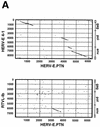Structure and phylogenetic analysis of an endogenous retrovirus inserted into the human growth factor gene pleiotrophin
- PMID: 9621070
- PMCID: PMC110412
- DOI: 10.1128/JVI.72.7.6065-6072.1998
Structure and phylogenetic analysis of an endogenous retrovirus inserted into the human growth factor gene pleiotrophin
Abstract
A human endogenous retrovirus-like element (HERV), flanked by long terminal repeats of 502 and 495 nucleotides is inserted into the human pleiotrophin (PTN) gene upstream of the open reading frame. Based on its Glu-tRNA primer binding site specificity and the location within the PTN gene, we named this element HERV-E.PTN. HERV-E.PTN appears to be a recombined viral element based on its high homology (70 to 86%) in distinct areas to members of two distantly related HERV type C families, HERV-E and retrovirus-like element I (RTVL-I). Furthermore, its pseudogene region is organized from 5' to 3' into gag-, pol-, env-, pol-, env-similar sequences. Interestingly, full-length and partial HERV-E.PTN-homologous sequences were found in the human X chromosome, the human hereditary haemochromatosis region, and the BRCA1 pseudogene. Finally, Southern analyses indicate that the HERV-E.PTN element is present in the PTN gene of humans, chimpanzees, and gorillas but not of rhesus monkeys, suggesting that genomic insertion occurred after the separation of monkeys and apes about 25 million years ago.
Figures











Similar articles
-
Human trophoblast and choriocarcinoma expression of the growth factor pleiotrophin attributable to germ-line insertion of an endogenous retrovirus.Proc Natl Acad Sci U S A. 1996 Dec 10;93(25):14759-64. doi: 10.1073/pnas.93.25.14759. Proc Natl Acad Sci U S A. 1996. PMID: 8962128 Free PMC article.
-
Identification of a novel family of human endogenous retroviruses and characterization of one family member, HERV-K(C4), located in the complement C4 gene cluster.Nucleic Acids Res. 1994 Dec 11;22(24):5211-7. doi: 10.1093/nar/22.24.5211. Nucleic Acids Res. 1994. PMID: 7816608 Free PMC article.
-
Influence of the human endogenous retrovirus-like element HERV-E.PTN on the expression of growth factor pleiotrophin: a critical role of a retroviral Sp1-binding site.Oncogene. 2000 Aug 17;19(35):3988-98. doi: 10.1038/sj.onc.1203742. Oncogene. 2000. PMID: 10962555
-
Molecular biology of type A endogenous retrovirus.Kitasato Arch Exp Med. 1990 Sep;63(2-3):77-90. Kitasato Arch Exp Med. 1990. PMID: 1710682 Review.
-
HERV-K: the biologically most active human endogenous retrovirus family.J Acquir Immune Defic Syndr Hum Retrovirol. 1996;13 Suppl 1:S261-7. doi: 10.1097/00042560-199600001-00039. J Acquir Immune Defic Syndr Hum Retrovirol. 1996. PMID: 8797733 Review.
Cited by
-
Evolutionary impact of transposable elements on genomic diversity and lineage-specific innovation in vertebrates.Chromosome Res. 2015 Sep;23(3):505-31. doi: 10.1007/s10577-015-9493-5. Chromosome Res. 2015. PMID: 26395902 Review.
-
An alternative approach to medical genetics based on modern evolutionary biology. Part 4: HERVs in cancer.J R Soc Med. 2009 Nov;102(11):474-80. doi: 10.1258/jrsm.2009.090289. J R Soc Med. 2009. PMID: 19875536 Free PMC article. Review. No abstract available.
-
Midkine and Pleiotrophin Concentrations in Amniotic Fluid in Healthy and Complicated Pregnancies.PLoS One. 2016 Apr 18;11(4):e0153325. doi: 10.1371/journal.pone.0153325. eCollection 2016. PLoS One. 2016. PMID: 27089523 Free PMC article.
-
Human endogenous retrovirus group E and its involvement in diseases.Viruses. 2015 Mar 16;7(3):1238-57. doi: 10.3390/v7031238. Viruses. 2015. PMID: 25785516 Free PMC article. Review.
References
-
- Andrake M D, Skalka A M. Retroviral integrase, putting the pieces together. J Biol Chem. 1996;271:19633–19636. - PubMed
-
- Bloch B, Normand E, Kovesdi I, Böhlen P. Expression of the HBNF (heparin-binding neurite-promoting factor) gene in the brain of fetal, neonatal and adult rat: an in situ hybridization study. Dev Brain Res. 1992;70:267–278. - PubMed
-
- Brown M A, Chun-Fang X, Nicolai H, Griffiths B, Chambers J A, Black D, Solomon E. The 5′-end of the BRCA1 gene lies within a duplicated region of human chromosome 17q21. Oncogene. 1996;12:2507–2513. - PubMed
Publication types
MeSH terms
Substances
Associated data
- Actions
Grants and funding
LinkOut - more resources
Full Text Sources
Other Literature Sources
Miscellaneous

